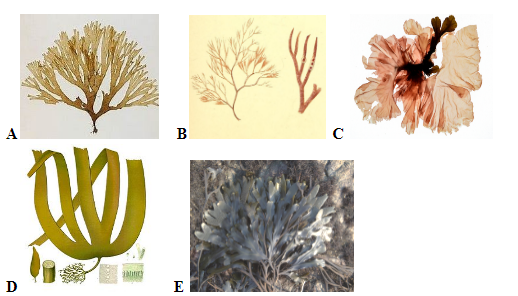
In the diagram given below some of the algae are labeled as 'A', 'B', 'C', 'D', and 'E'. These algae are respectively identified as

A. Dictyota, Polysiphonia, Porphyra, Fucus, and Laminaria
B. Porphyra, Dictyota, Laminaria, Fucus, and Polysiphonia
C. Dictyota, Polysiphonia, Porphyra, Laminaria, and Fucus
D. Fucus, Porphyra, Dictyota, Polysiphonia, and Laminaria

Answer
567.9k+ views
Hint: Algae are classified based upon their color and appearance. The most common classes of algae are Chlorophyceae (green algae), Rhodophyceae (red algae), and Phaeophyceae (brown algae). They are further classified into different genera based upon its characteristics. Algae are mostly found at the base of water bodies, in wet and marshy areas.
Complete answer:
Dictyota is a genus of brown algae. It is commonly found in the European Atlantic coasts and the Mediterranean Sea.
Dictyota has flat, dichotomously-branched thallus. They are brown. The algae labeled as A may be dictyota.
Polysiphonia is a genus that belongs to the class of red algae.
They are filamentous. The filaments are called 'siphons'. The central siphon stands erect and is surrounded by 4 or more siphons. Thus it is called polysiphonia. Figure B may be polysiphonia algae.
Porphyra is an alga related to the class Rhodophyceae (red algae). It is seaweed. It has a flat disc-shaped body. Figure C may be Porphyra algae.
Laminaria is a genus that belongs to the class of brown algae. They have long leaves with flat blades. They resemble the leaves of a tree. The algae labeled as D may be Laminaria.
Fucus is a genus of brown algae. It has fork-like wavy leaves with a visible mid-rib. The leaves are attached to a flat stalk. The picture labeled as E maybe focus.
As per the physical characters visible in the given picture, the correct answer is option (C).
Note:
> The algae of the genus Dictyota, Laminaria, Fucus belong to the brown-algae i.e class Phaeophyceae.
> The algae of the genus Polysiphonia, Porphyra belong to the red algal class i.e Rhodophyceae.
> Porphyra algae are used as a food ingredient in many countries like China, Japan, Korea, etc. It is traditionally used for the treatment of goiter and thyroid.
Complete answer:
Dictyota is a genus of brown algae. It is commonly found in the European Atlantic coasts and the Mediterranean Sea.
Dictyota has flat, dichotomously-branched thallus. They are brown. The algae labeled as A may be dictyota.
Polysiphonia is a genus that belongs to the class of red algae.
They are filamentous. The filaments are called 'siphons'. The central siphon stands erect and is surrounded by 4 or more siphons. Thus it is called polysiphonia. Figure B may be polysiphonia algae.
Porphyra is an alga related to the class Rhodophyceae (red algae). It is seaweed. It has a flat disc-shaped body. Figure C may be Porphyra algae.
Laminaria is a genus that belongs to the class of brown algae. They have long leaves with flat blades. They resemble the leaves of a tree. The algae labeled as D may be Laminaria.
Fucus is a genus of brown algae. It has fork-like wavy leaves with a visible mid-rib. The leaves are attached to a flat stalk. The picture labeled as E maybe focus.
As per the physical characters visible in the given picture, the correct answer is option (C).
Note:
> The algae of the genus Dictyota, Laminaria, Fucus belong to the brown-algae i.e class Phaeophyceae.
> The algae of the genus Polysiphonia, Porphyra belong to the red algal class i.e Rhodophyceae.
> Porphyra algae are used as a food ingredient in many countries like China, Japan, Korea, etc. It is traditionally used for the treatment of goiter and thyroid.
Recently Updated Pages
Master Class 12 English: Engaging Questions & Answers for Success

Master Class 12 Economics: Engaging Questions & Answers for Success

Master Class 12 Social Science: Engaging Questions & Answers for Success

Master Class 12 Maths: Engaging Questions & Answers for Success

Master Class 12 Chemistry: Engaging Questions & Answers for Success

Master Class 12 Business Studies: Engaging Questions & Answers for Success

Trending doubts
What are the major means of transport Explain each class 12 social science CBSE

Which are the Top 10 Largest Countries of the World?

Draw a labelled sketch of the human eye class 12 physics CBSE

Explain sex determination in humans with line diag class 12 biology CBSE

The pH of the pancreatic juice is A 64 B 86 C 120 D class 12 biology CBSE

Explain sex determination in humans with the help of class 12 biology CBSE




